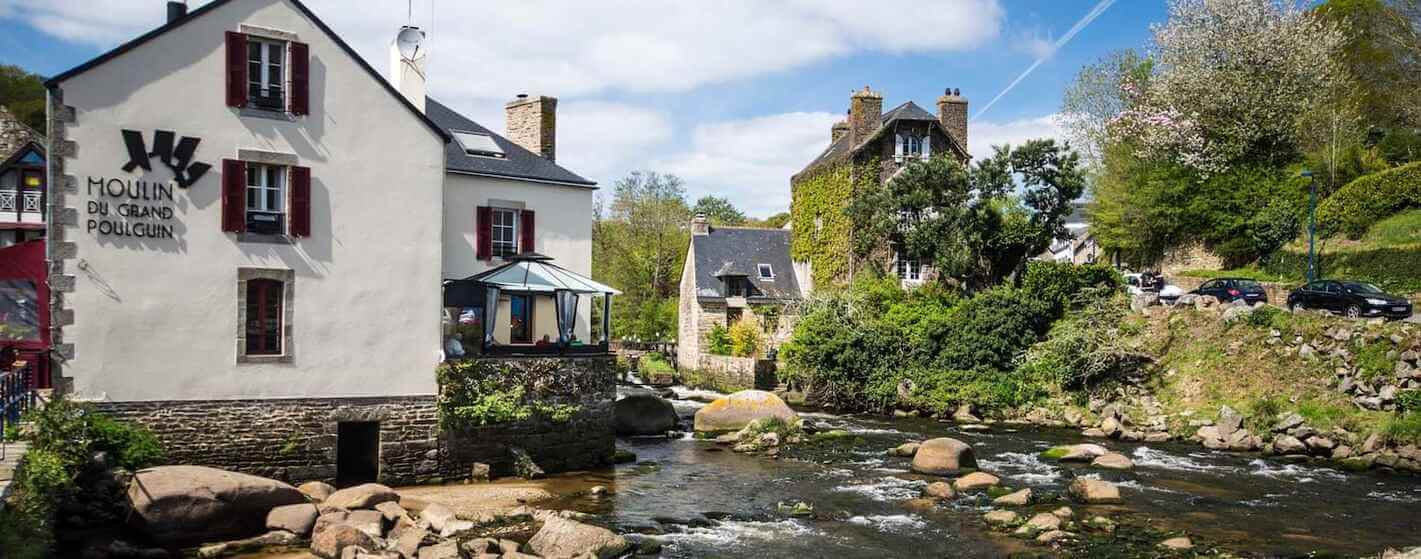Nestled in the heart of Brittany, the charming town of Pont-Aven has attracted visitors from far and wide for generations, not only for its picturesque landscapes but also for its rich milling past. These historic gems, scattered along the Aven River, once played a vital role in the city’s economy and daily life. During your stay at our Fouesnant Le Kervastard campsite, embark on a journey through time to discover the 14 mills of Pont-Aven and their well-kept secrets.
The history of the Pont-Aven mills
The River Aven, which winds through the town, provided an ideal location for the establishment of the mills. From the Middle Ages, local residents recognized the hydraulic potential of the Aven and began to establish mills along its banks.
If mills were initially dedicated to grinding cereals, particularly to produce flour, their use has diversified over the centuries. There were paper mills, sawmills, and even mills dedicated to electricity production. This diversity of use reflects the ingenuity and adaptability of residents to the changing needs of the local economy.
In the 19th century, Pont-Aven experienced a period of prosperity thanks to its mills. They have become real centers of activity, employing a large part of the local population. It was also at this time that the saying “Pont-Aven, renowned town, 14 mills, 15 houses” was born, illustrating the importance of mills in daily life and the identity of the town.
With the advent of new technologies and modernization, many mills ceased their traditional activities. Some have been transformed into restaurants, artists’ studios or exhibition spaces, while others, unfortunately, have been left abandoned.
The mills of Bois d’Amour
A calm, soothing and enchanting place, the Bois d’Amour has always been a source of inspiration for the greatest painters of the 19th century. Between woods and river, let yourself be carried away by this magnificent wild vegetation along the stream and discover 3 of the mills that make Pont-Aven famous!
The Haut Bois mill
The Haut Bois mill, also called the black wood mill, Meil Coat Du in Breton, was built in 1724 as indicated by the sign on its front door. It was formerly governed by the Lord of the Haut Bois, hence its name. In 1951, it ceased its activity. But, in 1959, it resumed its functions thanks to the new owner who installed a turbine producing electric current.
The Plessis mill
The Plessis mill bears the same name as the Plessis manor, a few meters up the hill. They are both property of the Villemarqué family, as are the Bois d’Amour and the Trémalo chapel. Today, the mill is nothing but dust at a place called Mainguinis. At its location, we can observe a diversion canal which is used for fish farming.
The New Mill
Standing majestically at the entrance to the Bois d’Amour, the Neuf mill has ceased its activity since 1900. Its traditional architecture and its proximity to the stream make it a perfect place for a contemplative break. Although its activity was short-lived, the Neuf mill remains an important witness to the history of Pont-Aven.
The mills of the Pont-Aven Viaduct
Witnesses to Pont-Aven’s industrial and artisanal past, the 2 mills of the Viaduc stood majestically near the imposing arches of the viaduct, thus blending the history of man with that of the surrounding nature.
The Kermentec mill
Formerly called the David mill, in reference to its original owner, the Kermentec mill was originally a paper mill, then it became a grain mill. Little is known about the origins of this mill, but one thing is certain: it is very popular. Gauguin immortalized him in 1894, then Daucho in 1943.
The Kerniguez mill
Standing proudly on the left bank of the Aven, the Kerniguez mill is another jewel of this region. Unfortunately, this stone structure has now disappeared, but its imprint remains in the collective memory, recalling the days when mills dotted the landscape, transforming the grains.
The mills of the Xavier Grall promenade
Named after the famous Breton poet, the Xavier Grall walk is a short walk on the footbridges overlooking the Aven river. It offers breathtaking views of the chaos of the city, the flowery avenues, the watercourse, but above all the mills. Discover 5 of the Pont-Aven mills that you can visit during the Xavier Grall walk!
The Petit Poulguin mill
Accessible via rue du Général de Gaulle, the Petit Poulguin mill takes its name from its proximity to the chaos of Pont-Aven. In Breton, Poul means hole and Guin means tumult.
The Pénanros mill
The Pénanros mill bears the same name as the stream which ends up in the Aven very close to the mill. Originally, it was a property of the Saint Maurice de Quimperlé abbey. Then, it was bought by Yves Lollichon in 1791. Today, the five-story flour mill renovated in 1928 is still in operation under the directives of the Dérouts, direct descendants of the Lollichons.
The Brunou sawmill mill
The Brunou sawmill no longer exists today. But the location of its old wheel is still recognizable in front of the medallion of the Xavier Grall promenade.
The Petite Tourte mill
The Petite Tourte mill was a sawmill before becoming a mill. He is the only one in the city to receive water from the Pénanros over the wheel.
The Poulhas mill
The Poulhas mill or “duck pond” in Breton, is a mill which was transformed into a flour mill at the beginning of the 20th century, then into a bank branch today.
The mills of rue du port
On the rue du port where a number of interesting businesses are located in the heart of the city center, very close to the inhabited bridge, discover 4 of the famous Pont-Aven mills!
The Rosmadec mill
The Rosmadec mill was built in the 15th century by the Marquis de Rosmadec and became an outbuilding of the castle. It ceased its activity in 1925. Then, it underwent several transformations: first, an artist’s studio, then an exhibition space, then a creperie and finally a restaurant. In 1933, it was even the first Michelin-starred restaurant in Finistère.
The mill of La Porte Neuve
The mill of La Porte Neuve was a property of the Lord of La Porte Neuve of Riec-sur-Belon, then it passed to the Lord of Hénan in Névez. It is also called the Hénan water mill in opposition to the sea mill in Névez. After several auctions, the mill is today owned by Job Péron. On the roof, the sculptures surprise and amaze.
The Ty Meur or St Guénolé mill
The St Guénolé mill bears the same name as the hill which hosts it. It is also called Ty Meur which means large house in Breton. Its beauty is such that Gauguin immortalized it in 1888.
The Grand Poulguin mill
The Grand Poulguin mill now houses a restaurant. Thanks to its granite walls, its exposed beams and its large Breton fireplace, it was chosen as the setting for the film “Les galettes de Pont-Aven”.
View all our articles
